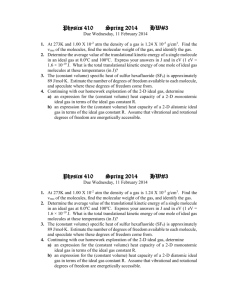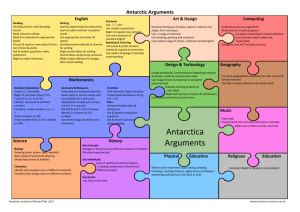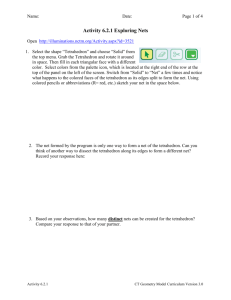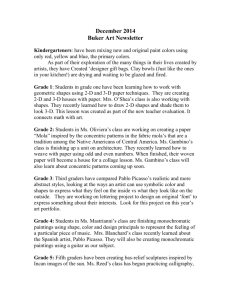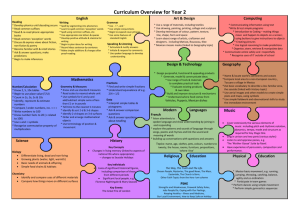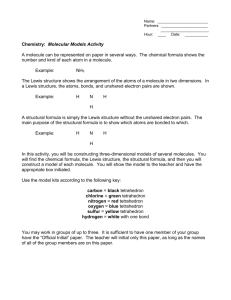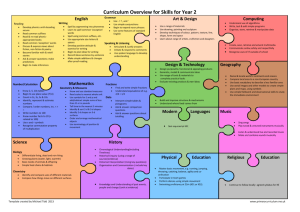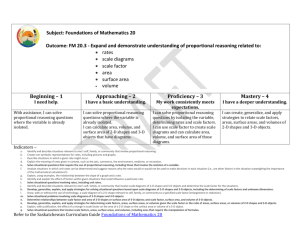2-D Representation of Simple Solids
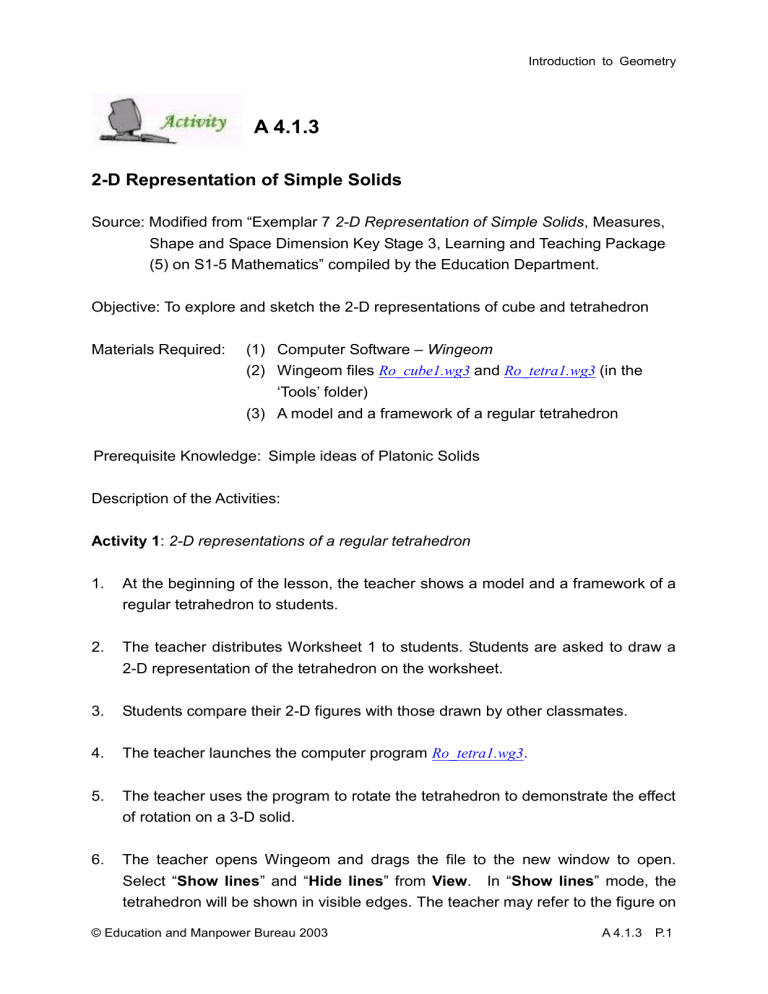
Introduction to Geometry
A 4.1.3
2-D Representation of Simple Solids
Source: Modified from “Exemplar 7 2-D Representation of Simple Solids , Measures,
Shape and Space Dimension Key Stage 3, Learning and Teaching Package
(5) on S15 Mathematics” compiled by the Education Department.
Objective: To explore and sketch the 2-D representations of cube and tetrahedron
Materials Required: (1) Computer Software – Wingeom
(2) Wingeom files Ro_cube1.wg3
and Ro_tetra1.wg3 (in the
‘Tools’ folder)
(3) A model and a framework of a regular tetrahedron
Prerequisite Knowledge: Simple ideas of Platonic Solids
Description of the Activities:
Activity 1 : 2-D representations of a regular tetrahedron
1. At the beginning of the lesson, the teacher shows a model and a framework of a regular tetrahedron to students.
2. The teacher distributes Worksheet 1 to students. Students are asked to draw a
2-D representation of the tetrahedron on the worksheet.
3. Students compare their 2-D figures with those drawn by other classmates.
4. The teacher launches the computer program Ro_tetra1.wg3
.
5. The teacher uses the program to rotate the tetrahedron to demonstrate the effect of rotation on a 3-D solid.
6. The teacher opens Wingeom and drags the file to the new window to open.
Select
“
Show lines
” and “
Hide lines
” from
View . In
“
Show lines
” mode, the tetrahedron will be shown in visible edges. The teacher may refer to the figure on
© Education and Manpower Bureau 2003 A 4.1.3 P.1
Introduction to Geometry the next page. Students can use different view modes to visualize the same solid.
7. The teacher should point out to students that, in the “ Hide lines
” Mode, there may be a hidden edge on the screen.
8. Students are asked to complete the Table of Worksheet 1. Students need to draw different 2-D representations of the tetrahedron with the help of the software. The teacher can make remarks for the use of a dotted line to represent an invisible edge in drawing the 2-D representation of a 3-D solid.
9. The teacher discusses with students the best 2-D representation of the tetrahedron.
© Education and Manpower Bureau 2003 A 4.1.3 P.2
Introduction to Geometry
Activity 2 : 2-D representation of a cube
1. The teacher distributes Worksheet 2 to students.
2. Students need to make use of the program Ro_cube1.wg3
to visualize the cube and its 2-D representations.
3. Students should be encouraged to discuss the discrepancies in their drawings.
4. The teacher guides students to draw the conclusions.
© Education and Manpower Bureau 2003 A 4.1.3 P.3
Introduction to Geometry
Worksheet 1 :
2-D representation of a regular tetrahedron
1. Draw a 2-D representation of the tetrahedron in the space provided. Compare your figure with your classmates.
2-D representation of the regular tetrahedron
© Education and Manpower Bureau 2003 A 4.1.3 P.4
Introduction to Geometry
2. With the help of the program Ro_tetra1.wg3
, draw as many 2-D representations of the tetrahedron as you can in the Table below. Use a dotted line to represent a hidden edge in the drawing.
2-D representation of the regular tetrahedron
Table
© Education and Manpower Bureau 2003 A 4.1.3 P.5
Introduction to Geometry
Worksheet 2
: 2-D representations of a cube
1. Draw a 2-D representation of the cube in the space provided. Compare your figure with your classmates.
2-D representation of the cube
© Education and Manpower Bureau 2003 A 4.1.3 P.6
Introduction to Geometry
2. With the help of the program Ro_cube1.wg3
, draw as many 2-D representations of the cube as you can in the Table below. Use a dotted line to represent a hidden edge in the drawing.
2-D representation of the cube
Table
© Education and Manpower Bureau 2003 A 4.1.3 P.7
Introduction to Geometry
Suggested Answers:
1. In the exemplar, all the faces of the solids are regular polygons.
2. Before the lesson, the teacher should prepare a model and a framework of a regular tetrahedron for demonstration.
3. Worksheet 1 :
(a)
2-D representation of a regular tetrahedron
(b)
(c)
(e)
(d)
4. The teacher may ask students which of the above representations can “best” illustrate a tetrahedron. An ideal 2-D illustration should consist of visible edges and dotted lines representing the
“hidden” edges. Figure (a) and (c) are two examples to be introduced.
© Education and Manpower Bureau 2003 A 4.1.3 P.8
Introduction to Geometry
5. Worksheet 2 :
Solid
Cube
2-D representation
6. The teacher can use other models for the 2-D representations of simple solids in
Worksheet 2 such as a cylinder or a cone.
© Education and Manpower Bureau 2003 A 4.1.3 P.9
